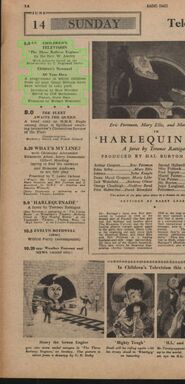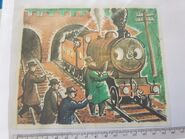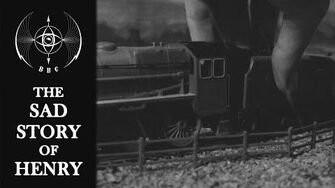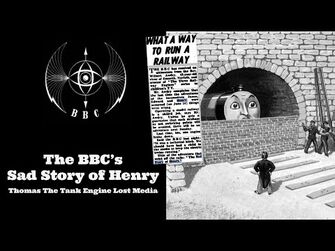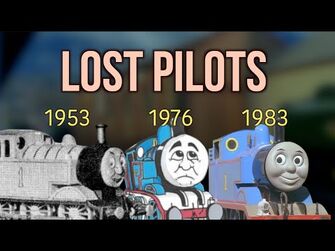mNo edit summary Tags: Visual edit Mobile edit Mobile web edit |
mNo edit summary Tags: Visual edit Mobile edit Mobile web edit |
||
| (6 intermediate revisions by 2 users not shown) | |||
| Line 1: | Line 1: | ||
| + | {{Lost|current_status=<nowiki></nowiki><span style="color:red;">'''Lost'''|image1=}} |
||
| − | |||
| − | '''The Railway Series''' is a set of British books about a railway system located on the fictional Island of Sodor. There are 42 books in the series, the first being published in 1945. Twenty-six were written by the Rev. Wilbert Awdry, up to 1972. A further 16 were written by his son, Christopher Awdry; 14 between 1983 and 1996, and two more in 2007 and 2011. It has been best known for been adapted for television in 1984 as '''Thomas the Tank Engine & Friends''' (later renamed as '''Thomas & Friends''', in |
+ | '''The Railway Series''' is a set of British books about a railway system located on the fictional Island of Sodor. There are 42 books in the series, the first being published in 1945. Twenty-six were written by the Rev. Wilbert Awdry, up to 1972. A further 16 were written by his son, Christopher Awdry; 14 between 1983 and 1996, and two more in 2007 and 2011. It has been best known for been adapted for television in 1984 as '''Thomas the Tank Engine & Friends''' (later renamed as '''Thomas & Friends''', in Series 7). While this is undoubtedly the most famous adaption of Awdry's stories, it was not the first. The first attempt was a live broadcast on June 14, 1953 by the BBC. However, the broadcast fared very poorly and caused plans for further adaptions to remain scrapped for three decades. |
==Background== |
==Background== |
||
| − | In 1953, the BBC approached ''The Railway Series'' editor Eric Marriott and inquired about the possibility of adapting two stories from ''The Railway Series'' for television on 14 June of that same year. The broadcast was to be done using 0O Gauge Hornby Dublo Models, while P.R. Wickham made the sets. This was to ensure that authenticity to the Author and Publishers requests. The episode was broadcast live from Lime Grove Studios on Sunday, June 14, 1953. |
+ | In 1953, the BBC approached ''The Railway Series'' editor Eric Marriott and inquired about the possibility of adapting two stories from ''The Railway Series'' for television on 14 June of that same year. The broadcast was to be done using 0O Gauge Hornby Dublo Models, while P.R. Wickham made the sets. This was to ensure that authenticity to the Author and Publishers requests. The episode was broadcast live from Lime Grove Studios on Sunday, June 14, 1953. |
| + | |||
| + | Six 0O gauge engine models shown in a ''Model Maker'' Magazine have rumored to have been the ones used, likely due to the photographs having been taken early in the same year. The written article however provides a description which contradict the claims. |
||
| − | ==Live Broadcast== |
+ | == Live Broadcast == |
The stories that the BBC chose to adapt was Wilbert Awdry's last two stories from his first book ("The Sad Story of Henry" and "Edward, Gordon and Henry"), in a new Children's Television program named '''''The Three Small Engines'''''. However, Douglas Mair (the director of Children's Television) had to deal with the 0O Gauge Models, superimposed rain, effects, music and narration by Julia Lang. The script was "freely adapted" to ensure the broadcasts met the ten-minute broadcast limit. The models were reported to jerk around as they moved. Other than that, the show went fine until one model engine derailed. This was caused by an operator not switching the points before the engine arrived at them. To the surprise of many viewers, a human hand picked up the engine and put it back on the rails! |
The stories that the BBC chose to adapt was Wilbert Awdry's last two stories from his first book ("The Sad Story of Henry" and "Edward, Gordon and Henry"), in a new Children's Television program named '''''The Three Small Engines'''''. However, Douglas Mair (the director of Children's Television) had to deal with the 0O Gauge Models, superimposed rain, effects, music and narration by Julia Lang. The script was "freely adapted" to ensure the broadcasts met the ten-minute broadcast limit. The models were reported to jerk around as they moved. Other than that, the show went fine until one model engine derailed. This was caused by an operator not switching the points before the engine arrived at them. To the surprise of many viewers, a human hand picked up the engine and put it back on the rails! |
||
| − | ==Aftermath== |
+ | == Aftermath== |
| − | The incident made the front page of several newspapers a week later, taking precedent over the murder trial of serial killer John Christie. This caused the June 21 broadcast to be delayed to June 28 and then |
+ | The incident made the front page of several newspapers a week later, taking precedent over the murder trial of serial killer John Christie. This caused the June 21 broadcast to be delayed to June 28 and then cancelled. Although numerous attempts were made to revive the series, all were unsuccessful until the early 80s. |
== Preservation== |
== Preservation== |
||
| Line 17: | Line 19: | ||
*The transmission of ''The Fleet awaits the Queen''. |
*The transmission of ''The Fleet awaits the Queen''. |
||
| − | ==Gallery |
+ | ==Gallery== |
| − | ===Other === |
||
<gallery position="center" spacing="small" orientation="landscape" navigation="true"> |
<gallery position="center" spacing="small" orientation="landscape" navigation="true"> |
||
| − | + | 0 IMG-20200519-WA0028.jpg|Original television airing schedule from ''Radio Times'' |
|
20200606 171130.png|Newspaper article |
20200606 171130.png|Newspaper article |
||
| − | + | 20190519 152947 (1).jpg|Possible end title card |
|
</gallery> |
</gallery> |
||
| Line 30: | Line 31: | ||
The Sad Story Of Henry UK-0|The 1984 version |
The Sad Story Of Henry UK-0|The 1984 version |
||
File:The BBC's Sad Story of Henry (1953) - Thomas and Friends Lost Media|ClickClackTrack's video on the subject. |
File:The BBC's Sad Story of Henry (1953) - Thomas and Friends Lost Media|ClickClackTrack's video on the subject. |
||
| + | File:Lost Thomas the Tank Engine Pilots -LostMedia|Scribbles to Screen's video mentioning The Sad Story of Henry's 1953 adaptation (0:42-3:43). |
||
</gallery> |
</gallery> |
||
==References== |
==References== |
||
| + | *[http://trlottte.com/mm_prw.htm Model Maker Magazine: THE LOCOMOTIVE FAMILY by PR Wickham (trlottte.com)] |
||
*[http://www.sodor-island.net/thetvserieshistory.html. Sodor-Island.net] |
*[http://www.sodor-island.net/thetvserieshistory.html. Sodor-Island.net] |
||
*[https://thomas-the-tank-engine-and-friends-youtube-series.fandom.com/wiki/Thomas_and_Friends Thomas the Tank Engine and Friends YouTube Series Wiki] |
*[https://thomas-the-tank-engine-and-friends-youtube-series.fandom.com/wiki/Thomas_and_Friends Thomas the Tank Engine and Friends YouTube Series Wiki] |
||
Revision as of 22:48, 30 July 2021
The Railway Series is a set of British books about a railway system located on the fictional Island of Sodor. There are 42 books in the series, the first being published in 1945. Twenty-six were written by the Rev. Wilbert Awdry, up to 1972. A further 16 were written by his son, Christopher Awdry; 14 between 1983 and 1996, and two more in 2007 and 2011. It has been best known for been adapted for television in 1984 as Thomas the Tank Engine & Friends (later renamed as Thomas & Friends, in Series 7). While this is undoubtedly the most famous adaption of Awdry's stories, it was not the first. The first attempt was a live broadcast on June 14, 1953 by the BBC. However, the broadcast fared very poorly and caused plans for further adaptions to remain scrapped for three decades.
Background
In 1953, the BBC approached The Railway Series editor Eric Marriott and inquired about the possibility of adapting two stories from The Railway Series for television on 14 June of that same year. The broadcast was to be done using 0O Gauge Hornby Dublo Models, while P.R. Wickham made the sets. This was to ensure that authenticity to the Author and Publishers requests. The episode was broadcast live from Lime Grove Studios on Sunday, June 14, 1953.
Six 0O gauge engine models shown in a Model Maker Magazine have rumored to have been the ones used, likely due to the photographs having been taken early in the same year. The written article however provides a description which contradict the claims.
Live Broadcast
The stories that the BBC chose to adapt was Wilbert Awdry's last two stories from his first book ("The Sad Story of Henry" and "Edward, Gordon and Henry"), in a new Children's Television program named The Three Small Engines. However, Douglas Mair (the director of Children's Television) had to deal with the 0O Gauge Models, superimposed rain, effects, music and narration by Julia Lang. The script was "freely adapted" to ensure the broadcasts met the ten-minute broadcast limit. The models were reported to jerk around as they moved. Other than that, the show went fine until one model engine derailed. This was caused by an operator not switching the points before the engine arrived at them. To the surprise of many viewers, a human hand picked up the engine and put it back on the rails!
Aftermath
The incident made the front page of several newspapers a week later, taking precedent over the murder trial of serial killer John Christie. This caused the June 21 broadcast to be delayed to June 28 and then cancelled. Although numerous attempts were made to revive the series, all were unsuccessful until the early 80s.
Preservation
As the show was broadcast live and knowing the BBC's track record for preserving old content, it is no surprise that the broadcast is lost. It is highly unlikely that anyone recorded the single broadcast, although other shows from that day have been kept and are available on the internet, such as:
- The live broadcast of the talk show What's My Line?;
- The transmission of The Fleet awaits the Queen.

